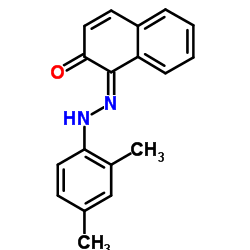

苏丹II结构式

|
常用名 | 苏丹II | 英文名 | Sudan II |
|---|---|---|---|---|
| CAS号 | 3118-97-6 | 分子量 | 276.33 | |
| 密度 | 1.1±0.1 g/cm3 | 沸点 | 429.6±55.0 °C at 760 mmHg | |
| 分子式 | C18H16N2O | 熔点 | 156-158ºC | |
| MSDS | 中文版 美版 | 闪点 | 213.6±31.5 °C |
|
Development and validation of a confirmatory HPLC method for simultaneous determination of Sudan dyes in animal tissues and eggs.
J. Chromatogr. Sci. 48(1) , 63-7, (2010) A simple and sensitive high-performance liquid chromatography (HPLC) analytical method for the simultaneous determination of six Sudan dyes (Sudan Red G, Sudan I, Sudan II, Sudan III, Sudan Red 7B, Sudan IV) in animal tissues and eggs was developed. Samples w... |
|
|
Development of a method for the analysis of seven banned azo-dyes in chilli and hot chilli food samples by pressurised liquid extraction and liquid chromatography with electrospray ionization-tandem mass spectrometry.
Talanta 78(1) , 178-86, (2009) An automated, confirmatory and sensitive procedure has been developed and validated for the determination of Sudan (I-IV), Sudan Orange G, Sudan Red 7B and Para Red in hot chilli food samples. The proposed method includes pressurised liquid extraction (PLE) w... |
|
|
Preparation of anti-Sudan red monoclonal antibody and development of an indirect competitive enzyme-linked immunosorbent assay for detection of Sudan red in chilli jam and chilli oil.
Analyst 135(10) , 2566-72, (2010) Sudan dyes are banned to be used in food additives because of the carcinogenicity of their metabolites. A rapid and sensitive indirect competitive enzyme-linked immunosorbent assay (ELISA) was developed to detect the residues of Sudan dyes. Novel immunogen an... |
|
|
Determining the adulteration of spices with Sudan I-II-II-IV dyes by UV-visible spectroscopy and multivariate classification techniques.
Talanta 79(3) , 887-92, (2009) We propose a very simple and fast method for detecting Sudan dyes (I, II, III and IV) in commercial spices, based on characterizing samples through their UV-visible spectra and using multivariate classification techniques to establish classification rules. We... |
|
|
Determination of sudan dyes in red wine and fruit juice using ionic liquid-based liquid-liquid microextraction and high-performance liquid chromatography.
J. Sep. Sci. 34(14) , 1730-7, (2011) The liquid-liquid microextraction (LLME) was developed for extracting sudan dyes from red wine and fruit juice. Room temperature ionic liquid was used as the extraction solvent. The target analytes were determined by high-performance liquid chromatography. Th... |
|
|
Production of the monoclonal antibody against Sudan 2 for immunoassay of Sudan dyes in egg.
Anal. Biochem. 423(2) , 246-52, (2012) Many methods have been reported to determine the residues of Sudan dyes in food samples. Among the reported methods, enzyme-linked immunosorbent assay (ELISA) was a frequently used practical screen tool. In this study, a novel hapten of Sudan 2 was synthesize... |
|
|
Development of an enzyme-linked immunosorbent assay specific to Sudan red I.
Anal. Biochem. 405(1) , 41-9, (2010) To obtain antibodies to develop an enzyme-linked immunosorbent assay (ELISA) for the analysis of Sudan red I, haptens were designed and synthesized via four different strategies: (i) attachment of a spacer at the para position of the benzene ring, (ii) attach... |
|
|
Magnetic solid-phase extraction and ultrafast liquid chromatographic detection of Sudan dyes in red wines, juices, and mature vinegars.
J. Sep. Sci. 35(23) , 3403-11, (2012) A nanocomposite of polystyrene-coated magnetic nanoparticles was successfully synthesized and employed as adsorbent for magnetic solid-phase extraction of four Sudan dyes (I, II III, and IV) in red wines, juices, and mature vinegars. The prepared magnetic nan... |
|
|
An ultrasensitive and selective fluorescence assay for Sudan I and III against the influence of Sudan II and IV.
Biosens. Bioelectron. 42 , 136-40, (2013) We report on an ultrasensitive and selective fluorescence assay for Sudan I and III against the influence of Sudan II and IV based on ligand exchange mechanism. Calcein as a fluorescence indicator and Sudan I-IV as model analytes were employed to investigate ... |
|
|
Evaluation of impact of exposure of Sudan azo dyes and their metabolites on human intestinal bacteria.
Anaerobe 18(4) , 445-53, (2012) Sudan azo dyes are banned for food usage in most countries, but they are illegally used to maintain or enhance the color of food products due to low cost, bright staining, and wide availability of the dyes. In this report, we examined the toxic effects of the... |